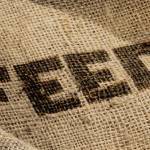Differences in Feeding Horses in the U.S. and U.K.

Horses are fed essentially the same things—forages and grains—all over the world, but the forms in which these basics feedstuffs are found may vary quite a bit depending on where the horses live. In the U.S., common forage choices are pasture, hay, or a nugget or pellet made from ground forage. Grain choices typically include pelleted or textured feeds (sweet feeds).
In the U.K., horses may be given feeds containing some micronized grains, an option that is not generally found in the U.S. Micronizing has somewhat the same effect on grain as extrusion, and there are advantages to the horse from both processes. In micronizing, cereal grains are heated under an infrared cooker. When infrared rays penetrate grains or seeds, they cause the molecules of the material to vibrate at a frequency of 80-170 million megacycles per second. This triggers rapid internal heating and a rise in water vapor pressure. The material becomes soft and plastic, causing it to swell and fracture. Immediate flaking gelatanizes the starches, making them easier for the horse to digest.
Because any starch that escapes digestion in the foregut can cause metabolic upset if it passes into the hindgut, easily digested starch reduces the chance of the horse developing problems like laminitis and colic that can be triggered by starch overflow. The majority of equine grain mixes produced in the U.K. contain some micronized flakes, though few companies depend entirely on micronized grains as a starch source.
Though hay is usually available in the U.S., Great Britain has limited hay production and a number of horses therefore eat haylage. This forage alternative is made from mature grass that is cut and wilted for 24 hours, then baled and compressed. This results in anaerobic fermentation, with mild lactic acid pickling the grass. Once they become familiar with the taste, horses seem to like the tart flavor.
There are a few problems associated with feeding haylage, mainly due to its high water content. Horse owners who feed the same weight of haylage that they have been feeding as hay will be providing their horses with only about half the intake of fiber as well as a lower level of vitamins and minerals. In addition, the horses will be getting extra energy from haylage compared to the same weight of hay. Because of the reduction in dry matter intake, some horses being fed haylage have developed behavioral abnormalities such as wood chewing or manure consumption.
Rarely seen in the U.S., chaff (chopped forage) is commonly added to concentrate feeds in the U.K. Generally speaking, about a pound (0.5 kg) of chaff is mixed into each grain meal. Types of chaff available in Great Britain include molassed straw chaff, containing between 40 and 60% molasses; high-temperature dried alfalfa chaff with 10 to 20% molasses; a straw and alfalfa 50:50 mix; and unmolassed pure hay and straw chaffs. Horses tend to chew more and eat a bit more slowly when chaff is added to grain meals. These factors may reduce the risk of choke as well as introducing more fiber into the horse’s diet.








